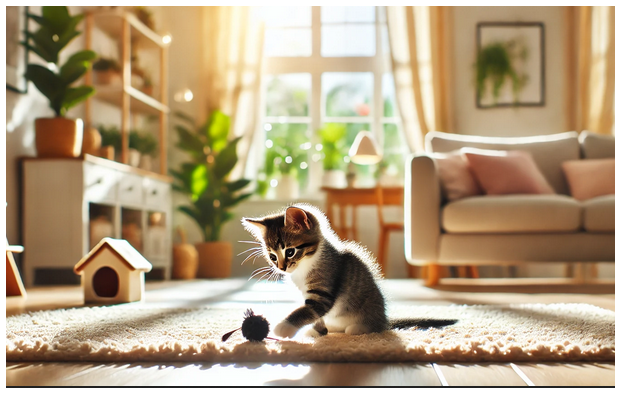Bringing a new kitten into your home is an exciting experience filled with joy, cuddles, and playful moments. But with all that excitement comes responsibility, especially when it comes to making sure your home is safe and kitten-proofed. Kittens are naturally curious creatures, and their boundless energy can get them into sticky (or dangerous!) situations if precautions aren’t taken. Here’s a comprehensive guide on cat-proofing your house and ensure a safe environment for your tiny new companion.
1. Secure Electrical Cords and Outlets
Kittens love to pounce on anything that moves, and electrical cords can be particularly enticing. To prevent chewing on cords, which could lead to shocks or burns, follow these tips:
- Use cord covers: Special cord protectors or conduit tubing can keep wires bundled and out of sight.
- Unplug unused devices: If you’re not using an appliance, unplug it so the cord isn’t a temptation.
- Block access to outlets: Use childproof outlet covers to prevent tiny paws from exploring dangerous outlets.
2. Put Away Hazardous Chemicals
Kitchens, bathrooms, and garages can all be home to hazardous chemicals. From cleaning supplies to antifreeze, many substances can be toxic to kittens if ingested.
- Store securely: Keep cleaning products, detergents, and medications in closed cabinets that your kitten can’t access.
- Use cabinet locks: If your kitten is particularly crafty, consider installing childproof latches on lower cabinets.
- Be mindful of laundry products: Dryer sheets and fabric softeners can be harmful to pets, so make sure these are kept out of reach.
3. Check for Small Objects
Kittens, much like human toddlers, explore the world by putting things in their mouths. This makes small items like buttons, rubber bands, paper clips, and hair ties particularly dangerous.
- Do a sweep of the floors: Regularly check your floors and surfaces for any small items that a kitten might find interesting—and swallow.
- Keep dangerous items in drawers or containers: Ensure that any choking hazards are kept in secure containers or drawers that your kitten can’t access.
4. Lock Away Toxic Plants
Many common houseplants are toxic to cats, and kittens might be tempted to nibble on them while exploring their new environment. Some common plants that are poisonous to cats include:
- Lilies
- Pothos
- Aloe Vera
- Sago Palm
- Philodendron
- Opt for cat-safe plants: If you want greenery in your home, consider plants like spider plants, Boston ferns, or cat grass.
- Move toxic plants to inaccessible areas: If you can’t part with your favorite plant, place it on high shelves or in hanging baskets well out of your kitten’s reach.
5. Install Window Screens
Kittens are naturally drawn to windows where they can watch birds, people, and other outdoor activities. However, open windows pose a risk.
- Check and secure window screens: Make sure all windows have properly installed screens to prevent your kitten from falling or escaping.
- Use window guards: If your windows don’t allow for screens, consider using window guards to create a barrier that still lets fresh air in without the risk.
6. Create Safe Climbing Zones
Kittens love to climb, whether it’s furniture, drapes, or anything they can get their paws on. While this can be adorable, it can also lead to accidents, like knocking over fragile items or falling from high places.
- Provide cat trees or shelves: Encourage safe climbing by setting up designated areas with cat trees or wall-mounted shelves designed for cats.
- Secure heavy objects: Make sure bookcases, lamps, or other items are secured and won’t tip over if your kitten decides to climb them.
7. Hide Breakables
Kittens love to bat at dangling objects or climb onto high surfaces, which can spell disaster for fragile items like vases, picture frames, or heirlooms.
- Keep fragile items out of reach: Place breakables on high shelves or inside enclosed cabinets.
- Use museum putty: To secure valuable or decorative items on surfaces, you can use museum putty, which helps hold them in place if they get bumped.
8. Secure Trash Cans
Trash cans can be a treasure trove for a curious kitten, but they often contain dangerous items like bones, plastic bags, or spoiled food.
- Use a lidded trash can: A trash can with a secure lid will prevent your kitten from digging through it.
- Keep trash cans in enclosed spaces: If possible, store trash cans in cabinets or closets where your kitten can’t get to them.
9. Beware of Open Toilets and Bathtubs
Kittens can easily fall into open toilets or bathtubs, which can lead to injury or drowning.
- Keep toilet lids closed: Make sure everyone in your household keeps the toilet lids closed at all times.
- Drain bathtubs immediately: Don’t leave standing water in your bathtub after use, and ensure that your kitten can’t access it when it’s not in use.
10. Be Cautious with Doors and Windows
Kittens are fast and sneaky, and it’s easy for them to dart out of an open door or window.
- Be mindful when opening doors: Check to make sure your kitten isn’t nearby when you’re entering or leaving the house.
- Use door stoppers: Keep doors from accidentally slamming shut, which could trap tiny paws or tails.
11. Secure Furniture and Shelving
Furniture that’s unstable or top-heavy can pose a risk for adventurous kittens who might knock it over while climbing or playing.
- Anchor furniture to the wall: Use furniture straps or anchors to secure bookshelves, dressers, and other heavy furniture to prevent tipping.
- Rearrange if necessary: If you have any wobbly or unstable furniture, consider removing it from rooms your kitten will frequent until they’re older and less likely to climb recklessly.
12. Kitten-Safe Zones
Sometimes the best way to protect your new kitten is by creating specific “kitten-safe zones” where they can play and explore without the risk of encountering hazards.
- Set up a designated kitten room: For the first few days, keep your kitten in a single room that’s been fully kitten-proofed. This will give them time to adjust and ensure they’re not wandering into dangerous areas.
- Use baby gates: If you want to restrict access to certain parts of your home, baby gates can help create safe boundaries while still allowing your kitten to explore.
13. Secure Your Curtains
Curtains and drapes are another common target for kittens, who see them as perfect toys to climb or bat at.
- Tie back long drapes: Use curtain tiebacks to keep them out of reach.
- Opt for shorter window treatments: If your kitten has a tendency to climb, consider switching to shorter curtains or blinds.
14. Check for Escape Routes
Kittens are masters at finding nooks and crannies to hide in, and in some cases, they may even find their way into spaces that could be dangerous, like behind large appliances or under furniture.
- Block off tiny spaces: Check for any gaps between furniture, under appliances, or behind cabinets, and use barriers to block them off if necessary.
- Be mindful of open doors: Keep doors to closets, laundry rooms, or outdoor spaces closed to prevent your kitten from sneaking in unnoticed.
Conclusion: Creating a Safe Haven for Your New Kitten
Welcoming a kitten into your home is a joyful experience, but it also requires a bit of preparation to ensure their safety. By taking the time to kitten-proof your home, you’ll be setting your new furry family member up for a happy, healthy, and safe life.
Remember, kittens grow quickly, and as they mature, they may outgrow some of their more dangerous behaviors. However, providing them with a safe and stimulating environment from the beginning will help prevent accidents and create a loving home where your kitten can thrive.
Now that you’ve got a kitten-proof home, it’s time to enjoy the wonderful chaos that a playful kitten brings!






